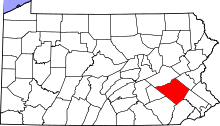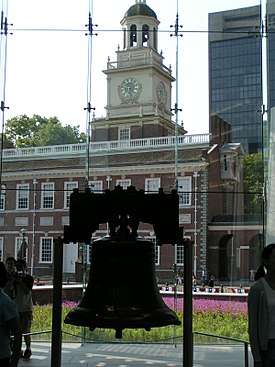Reading, Pennsylvania
| Reading, Pennsylvania | |
|---|---|
| City | |
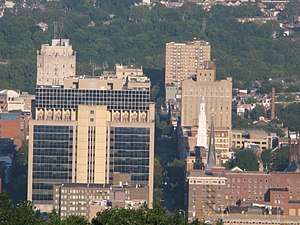   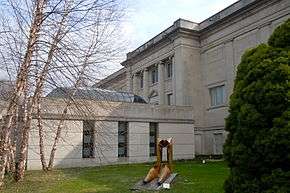 Top to bottom, left to right: (1) Reading skyline (2) Lindbergh Viaduct (3) First Energy Stadium (4) Pagoda (5) Reading Art Museum | |
| Nickname(s): Baseballtown,[1] Pretzel Capital of the World, Pretzel City [2] | |
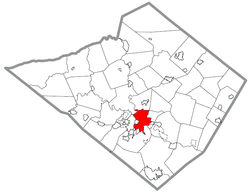 Reading's location in Berks County | |
 Reading Location in Pennsylvania and the United States  Reading Reading (the US) | |
| Coordinates: 40°20′30″N 75°55′35″W / 40.34167°N 75.92639°WCoordinates: 40°20′30″N 75°55′35″W / 40.34167°N 75.92639°W | |
| Country | United States |
| State | Pennsylvania |
| County | Berks |
| Founded | 1748 |
| Incorporated | September 15, 1783 (as a borough), March 16, 1847 (as a city)[3] |
| Named for | Reading, Berkshire |
| Government | |
| • Mayor | Wally Scott (D) |
| Area[4] | |
| • City | 10.13 sq mi (26.24 km2) |
| • Land | 9.87 sq mi (25.57 km2) |
| • Water | 0.26 sq mi (0.67 km2) |
| Elevation | 305 ft (93 m) |
| Population (2010)[5] | |
| • City | 88,082 |
| • Estimate (2016)[6] | 87,575 |
| • Density | 8,871.05/sq mi (3,425.30/km2) |
| • Urban | 266,254 (US: 140th) |
| • Metro | 413,521 (US: 128th) |
| Time zone | UTC−5 (EST) |
| • Summer (DST) | UTC−4 (EDT) |
| ZIP Codes | 19601-19612, 19640 |
| Area code(s) | 610, 484 |
| FIPS code | 42-63624 |
| Website |
www |
| Designated | 1948[7] |
Reading (/ˈrɛdɪŋ/ RED-ing; Pennsylvania German: Reddin) is a city in and the county seat of Berks County, Pennsylvania, United States. With a population of 87,575, it is the fifth-largest city in Pennsylvania.[8][9][10] Located in the southeastern part of the state, it is the principal city of the Greater Reading Area, and is furthermore included in the Philadelphia-Reading-Camden PA-NJ-DE-MD Combined Statistical Area.
The city, which is approximately halfway between the state's most populous city, Philadelphia, and the state capital, Harrisburg (as well as about halfway between Allentown and Lancaster) is strategically situated along a major transportation route from Central to Eastern Pennsylvania, and lent its name to the now-defunct Reading Railroad, which transported anthracite coal from the Pennsylvania Coal Region to the eastern United States via the Port of Philadelphia. Reading Railroad is one of the four railroad properties in the classic United States version of the Monopoly board game.
Reading was one of the first localities where outlet shopping became a tourist industry. It has been known as "The Pretzel City", because of numerous local pretzel bakeries. Currently, Bachman, Dieffenbach, Tom Sturgis, and Unique Pretzel bakeries call the Reading area home.
According to the 2010 census, Reading has the highest share of citizens living in poverty in the nation.[11]
In recent years, the Reading area has become a destination for cyclists. With more than 125 miles of trails in five major preserves, it is an International Mountain Bicycling Association Ride Center and held the Reading Radsport Festival on September 8–9, 2017.[12][13]
In April 2017, it was announced that an indoor velodrome, or cycling track, will be built in Reading as the first of its kind on the East Coast and only the second in the entire country. Albright College and the World Cycling League formally announced plans April 6, 2017, to build the $20 million, 2,500-seat facility, which will be called the National Velodrome and Events Center at Albright College. It will also serve as the Cycling League's world headquarters.[14]
History
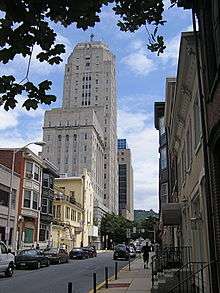
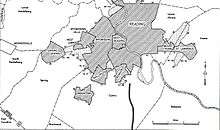
Lenni Lenape people, also known as "Delaware Indians", were the original inhabitants of the Reading area.
The Colony of Pennsylvania was a 1680 land grant from King Charles II of England to William Penn. Comprising more than 45,000 square miles (120,000 km2), it was named for his father, Sir William Penn.
In 1743, Richard and Thomas Penn (sons of William Penn) mapped out the town of Reading with Conrad Weiser. Taking its name from Reading, Berkshire, England, the town was established in 1748. Upon the creation of Berks County in 1752, Reading became the county seat. The region was settled by emigrants from southern and western Germany, who bought land from the Penns. The first Amish community in the New World was established in Greater Reading, Berks County.[15] The Pennsylvanian German dialect was spoken in the area well into the 1950s and later.
During the French and Indian War, Reading was a military base for a chain of forts along the Blue Mountain.

By the time of the American Revolution, the area's iron industry had a total production exceeding England's. That output helped supply George Washington's troops with cannons, rifles, and ammunition in the Revolutionary War. During the early period of the conflict, Reading was again a depot for military supply. Hessian prisoners from the Battle of Trenton were also detained here.
Philadelphia, Pennsylvania was the capital of the United States at the time of the Yellow Fever Epidemic of 1793.[16] President Washington traveled to Reading, and considered making it the emergency national capital, but chose Germantown instead.
Susanna Cox was tried and convicted for infanticide in Reading in 1809. Her case attracted tremendous sympathy; 20,000 viewers came to view her hanging, swamping the 3,000 inhabitants.
Census data showed that, from 1810 to 1950, Reading was among the nation's top one hundred largest urban places.
The Schuylkill Canal, a north-south canal completed in 1825, paralleled the Schuylkill River and connected Reading with Philadelphia and the Delaware River. The Union Canal, an east-west canal completed in 1828, connected the Schuylkill and Susquehanna Rivers, and ran from Reading to Middletown, Pennsylvania, a few miles south of Harrisburg, Pennsylvania. Railroads forced the abandonment of the canals by the 1880s.
The Philadelphia and Reading Railroad (P&R) was incorporated in 1833. During the Long Depression following the Panic of 1873, a statewide railroad strike in 1877 over delayed wages led to a violent protest and clash with the National Guard in which six Reading men were killed.[17] Following more than a century of prosperity, the Reading Company was forced to file for bankruptcy protection in 1971. The bankruptcy was a result of dwindling coal shipping revenues and strict government regulations that denied railroads the ability to set competitive prices, required high taxes, and forced the railroads to continue to operate money-losing passenger service lines. On April 1, 1976, the Reading Company sold its current railroad interests to the newly formed Consolidated Railroad Corporation (Conrail).
The Charles Evans Cemetery is the non-sectarian cemetery where many of the city's prominent business and community leaders have been buried since the cemetery's opening in the 1840s. Established through the donation of land by Reading attorney and philanthropist Charles Evans and a subsequent financial endowment upon his death in 1847, which provided for future improvements to the grounds,[18] the cemetery became a primary gathering point for annual Memorial Day activities from the late 19th through the late 20th centuries due to the presence of the Grand Army of the Republic monument, which was dedicated there in 1887.[19][20][21][22]
Early in the 20th century, the city participated in the burgeoning automobile and motorcycle industry as home to the pioneer "Brass Era" companies, Daniels Motor Company, Duryea Motor Wagon Company and Reading-Standard Company.[23]
Reading experienced continuous growth until the 1930s, when its population reached nearly 120,000. From the 1940s to the 1970s, however, the city saw a sharp downturn in prosperity, largely owing to the decline of the heavy industry and railroads, on which Reading had been built, and a national trend of urban decline.
In 1972, Hurricane Agnes caused extensive flooding in the city, not the last time the lower precincts of Reading were inundated by the Schuylkill River. A similar, though not as devastating, flood occurred during June 2006.
The 2000 census showed that Reading's population decline had ceased. This was attributed to an influx of Hispanic residents from New York City, as well as from the extension of suburban sprawl from Philadelphia's northwest suburbs.
Reading has its share of obstacles to overcome, namely crime.[24] However, new crime fighting strategies appear to have had an impact. In 2006, the city dropped in the rankings of dangerous cities, and again in 2007.
In December 2007, NBC's Today show featured Reading as one of the top four "Up and Coming Neighborhoods" in the United States as showing potential for a real estate boom.[25] The interviewee, Barbara Corcoran, chose the city by looking for areas of big change, renovations, cleanups of parks, waterfronts, and warehouses. Corcoran also noted Reading's proximity to Philadelphia, New York, and other cities.
Climate
| Reading, Pennsylvania | ||||||||||||||||||||||||||||||||||||||||||||||||||||||||||||
|---|---|---|---|---|---|---|---|---|---|---|---|---|---|---|---|---|---|---|---|---|---|---|---|---|---|---|---|---|---|---|---|---|---|---|---|---|---|---|---|---|---|---|---|---|---|---|---|---|---|---|---|---|---|---|---|---|---|---|---|---|
| Climate chart (explanation) | ||||||||||||||||||||||||||||||||||||||||||||||||||||||||||||
| ||||||||||||||||||||||||||||||||||||||||||||||||||||||||||||
| ||||||||||||||||||||||||||||||||||||||||||||||||||||||||||||
The climate in and around Reading is variable, but relatively mild. The Reading area is considered a humid subtropical climate, with areas just to the north designated as a humid continental climate. Summers are warm and humid with average July highs around 85 °F. Extended periods of heat and high humidity occur. On average, there are 15–20 days per year where the temperature exceeds 90 °F. Reading becomes milder in the autumn, as the heat and humidity of summer relent to lower humidity and temperatures. The first killing frost generally occurs in mid to late October.
Winters bring freezing temperatures, but usually move above freezing during the day's warmest point. The average January high is 38; the average January low is 22 °F, but it is not unusual for winter temperatures to be much lower or higher than the averages. The all-time record low (not including wind chill) was −21 °F during a widespread cold wave in January 1994. Snow is common in some winters, but the harsher winter conditions experienced to the north and west are not typical of Greater Reading. Annual snowfall is variable, but averages around 32 inches. Spring temperatures vary widely between freezing temperatures and the 80s or even 90s later in Spring. The last killing frost usually is in later April, but freezing temperatures have occurred in May. Total precipitation for the entire year is around 45 inches (112 cm).
| Climate data for Reading Regional Airport, Pennsylvania (1981–2010 normals,[lower-alpha 1] extremes 1894–present)[lower-alpha 2] | |||||||||||||
|---|---|---|---|---|---|---|---|---|---|---|---|---|---|
| Month | Jan | Feb | Mar | Apr | May | Jun | Jul | Aug | Sep | Oct | Nov | Dec | Year |
| Record high °F (°C) | 77 (25) |
82 (28) |
88 (31) |
97 (36) |
96 (36) |
102 (39) |
107 (42) |
105 (41) |
102 (39) |
94 (34) |
84 (29) |
77 (25) |
107 (42) |
| Mean maximum °F (°C) | 59.1 (15.1) |
60.6 (15.9) |
72.9 (22.7) |
83.6 (28.7) |
88.6 (31.4) |
92.5 (33.6) |
95.1 (35.1) |
93.5 (34.2) |
88.9 (31.6) |
80.8 (27.1) |
71.8 (22.1) |
60.7 (15.9) |
96.8 (36) |
| Average high °F (°C) | 37.7 (3.2) |
41.3 (5.2) |
50.7 (10.4) |
62.4 (16.9) |
72.4 (22.4) |
81.2 (27.3) |
85.2 (29.6) |
83.4 (28.6) |
75.7 (24.3) |
64.2 (17.9) |
53.4 (11.9) |
41.7 (5.4) |
62.5 (16.9) |
| Average low °F (°C) | 21.7 (−5.7) |
23.2 (−4.9) |
31.4 (−0.3) |
40.7 (4.8) |
49.9 (9.9) |
59.8 (15.4) |
64.3 (17.9) |
62.5 (16.9) |
55.0 (12.8) |
43.2 (6.2) |
34.7 (1.5) |
26.1 (−3.3) |
42.8 (6) |
| Mean minimum °F (°C) | 3.5 (−15.8) |
6.8 (−14) |
14.4 (−9.8) |
27.1 (−2.7) |
36.1 (2.3) |
46.2 (7.9) |
53.0 (11.7) |
50.5 (10.3) |
40.2 (4.6) |
29.9 (−1.2) |
21.2 (−6) |
10.6 (−11.9) |
0.8 (−17.3) |
| Record low °F (°C) | −20 (−29) |
−11 (−24) |
−2 (−19) |
16 (−9) |
26 (−3) |
36 (2) |
46 (8) |
42 (6) |
30 (−1) |
20 (−7) |
4 (−16) |
−6 (−21) |
−20 (−29) |
| Average precipitation inches (mm) | 3.05 (77.5) |
2.48 (63) |
3.48 (88.4) |
3.77 (95.8) |
4.24 (107.7) |
3.78 (96) |
4.52 (114.8) |
3.64 (92.5) |
4.34 (110.2) |
3.22 (81.8) |
3.46 (87.9) |
3.29 (83.6) |
43.27 (1,099.1) |
| Source: NOAA[26][28] | |||||||||||||
Geography
Reading is located at 40°20′30″N 75°55′35″W / 40.34167°N 75.92639°W (40.341692, −75.926301)[29] in southeastern Pennsylvania, roughly 65 miles (105 km) northwest of Philadelphia. According to the United States Census Bureau, the city has a total area of 10.1 square miles (26 km2). 9.8 square miles (25 km2) of it is land and 0.2 square miles (0.52 km2) of it (2.39%) is water. The total area is 2.39% water. The city is largely bounded on the west by the Schuylkill River, on the east by Mount Penn, and on the south by Neversink Mountain. The Reading Prong, the mountain formation stretching north into New Jersey, has come to be associated with naturally occurring radon gas; however, homes in Reading are not particularly affected. The surrounding county is home to a number of family-owned farms.
Economy
Companies based in Reading and surrounding communities include Boscov's, Carpenter, GK Elite Sportswear, Penske Truck Leasing, and Redner's Markets.
In 2012, The New York Times called Reading "the nation's poorest city."[30]
According to the Greater Reading Chamber of Commerce and Industry,[31] the largest employers in the Berks county area are:
| # | Employer | Employees |
|---|---|---|
| 1 | Reading Hospital | 6,878 |
| 2 | East Penn Manufacturing Co. | 6,851 |
| 3 | Carpenter | 2,432 |
| 4 | County of Berks | 2,370 |
| 5 | Reading School District | 1,903 |
| 6 | Pennsylvania Government | 1,886 |
| 7 | Wal-Mart Stores, Inc. | 1,818 |
| 8 | Boscov's | 1,740 |
| 9 | St. Joseph Medical Center | 1,566 |
| 10 | Penske Truck Leasing | 1,535 |
Jump Start Incubator, a program of Berks County Community Foundation and the Kutztown University Small Business Development Center, is intended to help entrepreneurs open new businesses in the area.[32]
Infrastructure
Transportation
A number of federal and state highways allow entry to and egress from Reading. U.S. Route 422, the major east-west artery, circles the western edge of the city and is known locally as The West Shore Bypass. US 422 leads west to Lebanon and east to Pottstown. U.S. Route 222 bypasses the city to the west, leading southwest to Lancaster and northeast to Allentown. Interstate 176 heads south from US 422 near Reading and leads to the Pennsylvania Turnpike (Interstate 76) in Morgantown. Pennsylvania Route 12 is known as the Warren Street Bypass, as it bypasses the city to the north. PA 12 begins at US 422/US 422 in Wyomissing and heads northeast on the Warren Street Bypass before becoming Pricetown Road and leading northeast to Pricetown. Pennsylvania Route 10 is known as Morgantown Road and heads south from Reading parallel to I-76 to Morgantown. Pennsylvania Route 61 heads north from Reading on Centre Avenue and leads to Pottsville. Pennsylvania Route 183 heads northwest from Reading on Schuylkill Avenue and Bernville Road, leading to Bernville. U.S. Route 222 Business is designated as Lancaster Avenue, Bingaman Street, South 4th Street, and 5th Street through Reading. U.S. Route 422 Business is designated as Penn Street, Washington Street (westbound), Franklin Street (eastbound), and Perkiomen Avenue through Reading.[33]
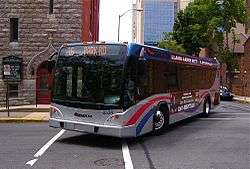
Public transit in Reading and its surrounding communities has been provided since 1973 by the Berks Area Regional Transportation Authority (BARTA). BARTA operates a fleet of 52 buses (including 23 hybrid electric buses) serving 19 routes, mostly originating at the BARTA Transportation Center in Downtown Reading. BARTA also provides paratransit service in addition to fixed route service. In addition, Greyhound and Bieber Transportation Group bus routes are available from the InterCity Bus Terminal. The former Reading Railroad Franklin Street Station was refurbished and reopened to bus service on September 9, 2013 with buses running the express route back and forth to Lebanon Transit. The route to Lebanon was discontinued after a short period, resulting in the refurbished station sitting vacant.
Reading and the surrounding area is serviced by the Reading Regional Airport, a general aviation airfield. The three-letter airport code for Reading is RDG. Scheduled commercial airline service to Reading ended in 2004, when the last airline, USAir stopped flying into Reading.[34]
Freight rail service in Reading is provided by the Norfolk Southern Railway, the Reading Blue Mountain and Northern Railroad, and the East Penn Railroad.[33] Norfolk Southern Railway serves Reading along the Harrisburg Line, which runs east to Philadelphia and west to Harrisburg, and the Reading Line, which runs northeast to Allentown. Norfolk Southern Railway operates the Reading Yard in Reading.[33][35] The Reading Blue Mountain and Northern Railroad operates the Reading Division line from an interchange with the Norfolk Southern Railway in Reading north to Port Clinton and Packerton.[36] The East Penn Railroad operates the Lancaster Northern line from Sinking Spring southwest to Ephrata, using trackage rights along Norfolk Southern Railway east from Sinking Spring to an interchange with the Norfolk Southern Railway in Reading.[37]
Passenger trains ran between Pottsville, Reading, Pottstown, and Philadelphia along the Pottsville Line until July 27, 1981, when transit operator SEPTA curtailed commuter service to electrified lines. Since then, there have been repeated calls for the resumption of the services.
In the late 1990s and up to 2003, SEPTA, in cooperation with Reading-based BARTA, funded a study called the Schuylkill Valley Metro which included plans to extend SEPTA's R6 passenger line to Pottstown, Reading, and Wyomissing, Pennsylvania. The project suffered a major setback when it was rejected by the Federal Transit Administration New Starts program, which cited doubts about the ridership projections and financing assumptions used by the study. With the recent surge in gasoline prices and ever-increasing traffic, the planning commissions of Montgomery County and Berks County have teamed to study the feasibility of a simple diesel shuttle train between the Manayunk/Norristown Line and Pottstown/Reading.[38] In 2018, a panel led by the Greater Reading Chamber Alliance pushed for an extension of the Manayunk/Norristown Line to Reading along existing Norfolk Southern freight railroad tracks, with service terminating either at the Franklin Street Station in Reading or in Wyomissing.[39]
Utilities
Electricity in Reading is provided by Met-Ed, a subsidiary of FirstEnergy.[40][41] Natural gas service in Reading is provided by UGI Utilities.[42][43] The Reading Area Water Authority provides water to the city, with the city's water supply coming from Lake Ontelaunee and the city's water treated at the Maidencreek Filter Plant. The Reading Water Company was founded in 1821 to supply water to the city. The Reading Area Water Authority was established on May 20, 1994 to take over the water system in the city.[44] Sewer service is provided by the city's Public Works department, with a wastewater treatment plant owned by the city located on Fritz Island.[45] The city's Public Works department provides trash and recycling collection to Reading.[46]
Health care
Hospitals serving the Reading area include Reading Hospital in West Reading and Penn State Health St. Joseph in Bern Township and downtown Reading. Reading Hospital offers an emergency department with a Level I trauma center and various services including Cancer Care, Heart Center, Orthopedic Services, Pediatrics, Primary Care, and Women's Health.[47] Penn State Health St. Joseph offers an emergency department, heart institute, cancer center, stroke center, wound center, orthopedics, and primary care physicians.[48]
Demographics
| Historical population | |||
|---|---|---|---|
| Census | Pop. | %± | |
| 1790 | 2,225 | — | |
| 1800 | 2,386 | 7.2% | |
| 1810 | 3,462 | 45.1% | |
| 1820 | 4,332 | 25.1% | |
| 1830 | 5,856 | 35.2% | |
| 1840 | 8,410 | 43.6% | |
| 1850 | 15,743 | 87.2% | |
| 1860 | 23,162 | 47.1% | |
| 1870 | 33,930 | 46.5% | |
| 1880 | 43,278 | 27.6% | |
| 1890 | 58,661 | 35.5% | |
| 1900 | 78,961 | 34.6% | |
| 1910 | 96,071 | 21.7% | |
| 1920 | 107,784 | 12.2% | |
| 1930 | 111,171 | 3.1% | |
| 1940 | 110,568 | −0.5% | |
| 1950 | 109,320 | −1.1% | |
| 1960 | 98,061 | −10.3% | |
| 1970 | 87,643 | −10.6% | |
| 1980 | 78,686 | −10.2% | |
| 1990 | 78,380 | −0.4% | |
| 2000 | 81,207 | 3.6% | |
| 2010 | 88,082 | 8.5% | |
| Est. 2016 | 87,575 | [6] | −0.6% |
| U.S. Decennial Census[49] 2013 Estimate[50] | |||
As of the 2010 census, the city was 48.4% White, 13.2% Black or African American, 0.9% Native American, 1.2% Asian, 0.1% Native Hawaiian, and 6.1% were two or more races. 58.2% of the population were of Hispanic or Latino ancestry.[51]
As of the census of 2000, there were 30,113 households, out of which 33.7% had children under the age of 18 living with them, 34.4% were married couples living together, 20.2% had a female householder with no husband present, and 38.8% were non-families. 31.7% of all households were made up of individuals, and 12.4% had someone living alone who was 65 years of age or older. The average household size was 2.63 and the average family size was 3.33.[52]
In the city, the population was spread out, with 29.9% under the age of 18, 11.7% from 18 to 24, 28.9% from 25 to 44, 17.0% from 45 to 64, and 12.4% who were 65 years of age or older. The median age was 31 years. For every 100 females, there were 93.3 males. For every 100 females age 18 and over, there were 88.5 males.
The median income for a household in the city was $26,698, and the median income for a family was $31,067. Males had a median income of $28,114 versus $21,993 for females. The per capita income for the city was $13,086. 26.1% of the population and 22.3% of families were below the poverty line. 36.5% of those under the age of 18 and 15.6% of those 65 and older were living below the poverty line.
Estimates
As of the American Community Survey 1-Year Estimates, Reading had a population of 80,997. The racial makeup of the city was 48.8% White, 14.0% African American, 0.2% Native American, 1.4% Asian, 0.0% Pacific Islander, 31.1% from other races, and 4.5% from two or more races. 56.3% were Hispanic or Latino of any race, with 33.5% being of Puerto Rican descent. 33.0% of all people were living below the poverty line, including 42.0% of those under 18.
According to the US Census Bureau, 32.9% of all residents live below the poverty level, including 45.7% of those under 18. Reading's unemployment rate in May 2010 was 14.7%, while Berks County's unemployment rate was 9.9%.[53]
Neighborhoods
| Name | Area | Population |
|---|---|---|
| Center City | 0.381 sq. mi | 5,374 |
| Callowhill | 0.751 sq. mi | 7,289 |
| Centre Park | 0.615 sq. mi | 10,781 |
| College Heights | 1.295 sq. mi | 14,903 |
| East Reading | 2.230 sq. mi | 34,572 |
| Eastside | 1.849 sq. mi | 29,198 |
| Glenside | 2.303 sq. mi | 11,837 |
| Hampden Heights | 3.144 sq. mi | 44,101 |
| Millmont | 1.024 sq. mi | 5,298 |
| North Riverside | 0.955 sq. mi | 12,674 |
| Northmont | 0.035 sq. mi | 697 |
| Northside | 0.187 sq. mi | 1,822 |
| Oakbrook/Wyomissing Park | 1.197 sq. mi | 5,947 |
| Outlet District | 0.554 sq. mi | 14,295 |
| Penn's Commons | 0.796 sq. mi | 15,891 |
| Prince Historic District | 0.123 sq. mi | 2,002 |
| Queen Anne Historic District | 0.330 sq. mi | 6,359 |
| Southside | 1.486 sq. mi | 10,317 |
| South of Penn | 1.122 sq. mi | 8,483 |
Fire department
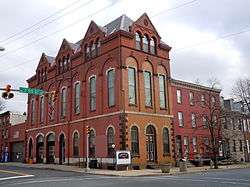
The city of Reading is protected by the 135 firefighters and paramedics of the Reading Fire and EMS Department (RFD). The RFD operates out of seven fire stations throughout the city. The RFD operates a fire apparatus fleet of five Engine Companies, three Ladder Companies, one Rescue Company, brush unit, and four front-line Medic Ambulances. In 2016, fire units responded to 9,751 incidents. EMS responses totaled 19,058 calls for service.[54] Department staffing is only two firefighters per apparatus.[55]
Education
.jpg)
The Reading School District provides elementary and middle schools for the city's children. Numerous Catholic parochial schools are also available.
Press reports have indicated that in 2012, about eight percent of Reading's residents have a college degree, compared to a national average of 28%.[30]
Four institutions of higher learning are located in Reading:
Four high schools serve the city:
- Berks Catholic High School (grades 9–12)
- Reading High School (grades 10–12)
- Reading Intermediate High School (grades 8–9)
- I-LEAD Charter School
Sports

Reading is known for the Reading Fightin Phils, minor league affiliate of the Philadelphia Phillies, who play at FirstEnergy Stadium. Notable alumni are Larry Bowa, Ryne Sandberg, Mike Schmidt, Ryan Howard, and Jimmy Rollins.
The city has been the residence of numerous professional athletes. Among these native to Reading are Brooklyn Dodgers outfielder Carl Furillo, Baltimore Colts running back Lenny Moore, and Philadelphia 76ers forward Donyell Marshall. Pro golfer Betsy King, a member of the World Golf Hall of Fame, was born in Reading.
The open-wheel racing portion of Penske Racing had been based in Reading, Pennsylvania since 1973 with the cars, during the F1 and CART era, being constructed in Poole, Dorset, England as well as being the base for the F1 team. On October 31, 2005, Penske Racing announced after the 2006 IRL season, they would consolidate IRL and NASCAR operations at the team's Mooresville, North Carolina facility; with the flooding in Pennsylvania in 2006, the team's operations were moved to Mooresville earlier than expected. Penske Truck Leasing is still based in Reading.
Duryea Drive, which ascends Mount Penn in a series of switchbacks, was a testing place for early automobiles and was named for Charles Duryea. The Blue Mountain Region Sports Car Club of America hosts the Duryea Hill Climb, the longest in the Pennsylvania Hillclimb Association series, which follows the same route the automaker used to test his cars.[56]
Reading played host to a stop on the PGA Tour, the Reading Open, in the late 1940s and early 1950s.
| Club | League | Venue | Established | Championships |
|---|---|---|---|---|
| Reading Fightin Phils | EL, Baseball | FirstEnergy Stadium | 1967 | 4 |
| Reading Royals | ECHL, Ice hockey | Santander Arena | 2001 | 1 |
| Reading United AC | PDL, Soccer | Don Thomas Stadium | 1996 |
Culture

The city's cultural institutions include the Reading Symphony Orchestra and its education project the Reading Symphony Youth Orchestra, the Reading Choral Society, Opus One: Berks Chamber Choir, the GoggleWorks Art Gallery, the Reading Public Museum and the Historical Society of Berks County.
Reading is the birthplace of graphic artist Jim Steranko, guitar virtuoso Richie Kotzen, novelist and poet John Updike, poet Wallace Stevens, and singer-songwriter Taylor Swift. Marching band composer and writer John Philip Sousa, the March King, died in Reading's Abraham Lincoln Hotel in 1932. Artist Keith Haring[57] was born in Reading.

Reading is home to the 15-time world-champion drum and bugle corps, the Reading Buccaneers.
In 1914, one the anchors of the Battleship Maine was delivered from the Washington Navy Yard to City Park, off of Perkiomen Avenue. The anchor was dedicated during a ceremony presided over by Franklin D. Roosevelt, who was then assistant secretary of the navy.
Reading was home to several movie and theater palaces in the early 20th Century. The Astor, Embassy, Loew's Colonial, and Rajah Shrine Theater were grand monuments of architecture and entertainment. Today, after depression, recession, and urban renewal, the Rajah is the only one to remain. The Astor Theater was demolished in 1998 to make way for The Sovereign Center. Certain steps were taken to retain mementos of the Astor, including its ornate Art Deco chandelier and gates. These are on display and in use inside the arena corridors, allowing insight into the ambiance of the former movie house. In 2000, the Rajah was purchased from the Shriners. After a much needed restoration, it was renamed the Sovereign Performing Arts Center.
The Mid-Atlantic Air Museum is a membership-supported museum and restoration facility located at Carl A. Spaatz Field. The museum actively displays and restores historic and rare war aircraft and civilian airliners. Most notable to their collection is a Northrop P-61 Black Widow under active restoration since its recovery from Mount Cyclops, New Guinea in 1989. Beginning in 1990, the museum has hosted "World War II Weekend Air Show", scheduled to coincide with D-Day. On display are period wartime aircraft (many of which fly throughout the show) vehicles, and weapons.
The mechanical ice cream scoop was invented in Reading by William Clewell in 1878. The 5th Ave Bar and York Peppermint Patty were invented in Reading.[15]
Sister city
The City of Reading and Reutlingen, Germany are sister cities which participate in student exchanges. Students from Reading High School can apply to become a part of the exchange and travel to Reutlingen for two weeks (mid-October to early September) and in return host German exchange students in the spring. Kutztown University also has a program with Reutlingen.
Reading is twinned with:

Attractions
.jpg)
In 1908, a Japanese-style pagoda was built on Mount Penn, where it overlooks the city and is visible from almost everywhere in town. Locally, it is called the "Pagoda". It is currently the home of a café and a gift shop. It remains a popular tourist attraction.
Another fixture in Reading's skyline is the William Penn Memorial Fire Tower, one mile from the Pagoda on Skyline Drive. Built in 1939 for fire department and forestry observation, the tower is 120 feet tall, and rises 950 feet above the intersection of fifth and Penn Streets. From the top of the tower is a 60-mile panoramic view.
The Reading Glove and Mitten Manufacturing Company founded in 1899, just outside Reading city limits, in West Reading and Wyomissing boroughs changed its name to Vanity Fair in 1911 and is now the major clothing manufacturer VF Corp. In the early 1970s, the original factories were developed to create the VF Outlet Village, the first outlet mall in the United States.
In media
The book and movie Rabbit, Run and the other three novels of the Rabbit series by John Updike were set in fictionalized versions of Reading and nearby Shillington, called Brewer and Olinger respectively. Updike was born in Reading and lived in nearby Shillington until he was thirteen. He also makes reference to the Brewer suburb of Mount Judge, equivalent to Mount Penn, east of Reading.
Filmmakers Gary Adelstein, Costa Mantis, and Jerry Orr created Reading 1974: Portrait of a City;[58] relying heavily on montage; the film is a cultural time capsule.
The play Sweat by Lynn Nottage is set in Reading.[59][60]
The movie Goon: Last of the Enforcers features Reading as the home of rival team, the Reading Wolf Dogs.
Notable people

- Gus Alberts (1861–1912), Major League Baseball player[61]
- Coit Albertson (1880–1953), silent film actor
- George Warren Alexander (1829–1903), US Army officer and founder of G.W. Alexander & Co., a hat factory[62]
- Elvin Ayala (b. 1981), professional boxer, World Boxing Council and U.S. National Boxing Council middleweight champion
- John Barrasso (b. 1952),[63] U.S. Senator from Wyoming
- Albert Boscov (1929–2017), chairman of Boscov's department store
- George Bradley (1852–1931), Major League Baseball player[61]
- Sylvanus C. Breyfogel (b. 1851), bishop of Evangelical Association
- Kenny Brightbill (b. 1948), race car driver
- James Bryant, professional football player
- Harry Buckwalter (1867–1930), photographer, journalist, film director and producer
- James Henry Carpenter (1846–1898), Civil War sailor, officer, founder of Carpenter Technology Corporation
- Jack Coggins (1911–2006), artist and author
- Kayla Collins (b. 1987), model and Playboy Playmate (August 2008)
- Forrest Compton (b. 1925), actor
- Michael Constantine (b. 1927), actor
- Tullio DeSantis (b. 1948), artist, writer, professor
- Lisa Eichhorn (b. 1952), actress, writer, producer
- Meg Foster (b. 1948), actress
- Roy Frankhouser (1939–2009), Grand Dragon of Ku Klux Klan
- Harry Whittier Frees (1879–1953), photographer
- Carl Furillo (1922–1989), Major League Baseball outfielder[61]
- Megan Gallagher (b. 1960), actress
- David McMurtrie Gregg (1833–1916), American Civil War general
- Keith Haring (1958–1990), artist, activist
- Mervin Heller, Jr., past president of the United States Tennis Association
- Corey Hertzog (b. 1990), professional soccer player
- William Muhlenberg Hiester (1818–1878), political and military leader
- Alice Hoover (1928–2014), All-American Girls Professional Baseball League player
- Frank Hovington (1919–1982), blues musician
- Chad Hurley (b. 1977), Co-founder and former CEO of YouTube
- Stu Jackson (b. 1955), executive vice president of basketball operations for the NBA
- Mildred Jordan (1901–1982), novelist
- Travis Kauffman (b. 1985), WBF Inter-Continental heavyweight boxing champion and ranked contender
- Ed Kemmer (1921–2004), combat pilot and actor
- Chip Kidd (b.1964), graphic designer and author
- A.S. King (b. 1970), author, winner of the LA Times Book Prize and a Printz Award honoree
- Betsy King (b.1955), golfer, winner of 34 LPGA Tour events and member of the World Golf Hall of Fame
- Richie Kotzen (b. 1970), rock guitarist
- Rick Krebs (b. 1949), game designer
- Whitey Kurowski (1918–1999), All-Star infielder for St. Louis Cardinals
- Henry Larkin (1860–1942), Major League Baseball player
- Julian Letterlough (1969–2005), light heavyweight boxing champion
- Steve Little (1965–2000), WBA world middleweight boxing champion
- Donyell Marshall (b. 1973), basketball player, Connecticut and NBA power forward
- Julio Cesar Matthews (b. 1970), Golden Gloves champion and unbeaten professional cruiserweight boxer
- Draya Michele (b. 1985), American social media personality, fashion designer, socialite, actress and model
- Morton L. Montgomery (1846–1933), Pennsylvania attorney and historian
- Lenny Moore (b. 1933), NFL running back and Pro Football Hall of Famer
- Stephen Mull, U.S. Assistant Secretary of State for Political Ministry Affairs, U.S. Ambassador to Lithuania[64]
- James Nagle (1822–1866), Civil War general
- Hildegard Peplau (1909–1999), nurse theorist
- Mike Pilot (b. 1975), podcaster
- David Robidoux, composer[65]
- Denise Rutkowski (b. 1962), professional female bodybuilder
- William Sands (1835–1918), U.S. Medal of Honor winner (Civil War)[66]
- Lori and George Schappell (b. 1961), conjoined twins
- John Philip Sousa (1854–1932), iconic composer, died in Reading
- Ray Dennis Steckler (1939–2009), film director
- Jim Steranko (b. 1938), Silver Age comic book artist, magazine publisher and escape artist
- Wallace Stevens (1879–1955), poet
- Taylor Swift (b. 1989), Grammy and Emmy Award-winning singer, songwriter and recording artist
- Chuck Thompson (1921–2005), sportscaster
- John Updike (1932–2009), Pulitzer Prize-winning novelist, poet, essayist
- Thomas Usher, CEO of U.S. Steel and Chairman of the Board of Marathon Oil
- Byron Vazakas (1905–1987), poet
- Charlie Wagner (1912–2006), baseball player for Boston Red Sox
- Lonnie Walker IV (b. 1998), NBA basketball player for San Antonio Spurs
- Angela Washko (b. 1986), artist
- Delores Wells (b. 1937), actress
- Thomas C. Zimmerman (1838–1914), writer, translator of English language classics to Pennsylvania German dialect
References
- ↑ Mean monthly maxima and minima (i.e. the highest and lowest temperature readings during an entire month or year) calculated based on data at said location from 1981 to 2010.
- ↑ Official precipitation measurements for Reading were taken at an undisclosed location from January 1894 to February 1973, a COOP 4 mi (6.4 km) north-northwest of downtown from March 1973 to January 1999, and Reading Regional since February 1999.[27] Temperature, snowfall and snow depth records date to February 1903, 23 November 1897, and 26 September 1908, respectively.[26]
- ↑ "Baseballtown Charities". baseballtown.org. November 27, 2012. Retrieved October 23, 2017.
- ↑ Kline, Dave. "Mountain Folklore: Berks Country Fest is all about music, culture, food". Reading Eagle. Retrieved 26 June 2017.
- ↑ "Archived copy" (PDF). Archived from the original (PDF) on March 17, 2016. Retrieved May 2, 2016.
- ↑ "2016 U.S. Gazetteer Files". United States Census Bureau. Retrieved Aug 13, 2017.
- ↑ "Population Estimates". United States Census Bureau. Archived from the original on May 22, 2014. Retrieved June 11, 2014.
- 1 2 "Population and Housing Unit Estimates". Retrieved June 9, 2017.
- ↑ "PHMC Historical Markers Search" (Searchable database). Pennsylvania Historical and Museum Commission. Commonwealth of Pennsylvania. Retrieved January 25, 2014.
- ↑ "Reading (city) QuickFacts from the US Census Bureau". census.gov. Retrieved October 20, 2017.
- ↑ "Find a County". National Association of Counties. Archived from the original on May 31, 2011. Retrieved June 7, 2011.
- ↑ "Census Shows Reading, Berks growth spurt". Retrieved March 13, 2011.
- ↑ Tavernise, Sabrina (September 26, 2011). "Reading, Pa., Knew It Was Poor. Now It Knows Just How Poor". The New York Times.
- ↑ "Reading (PA) Bronze-level | International Mountain Bicycling Association". www.imba.com. Retrieved 2016-10-14.
- ↑ "Reading Radsport Festival | September 8, 2017". www.readingradsport.com. Retrieved 2017-11-14.
- ↑ News, 69 (2017-04-06). "$20 million indoor cycling track to be built in Reading". WFMZ. Retrieved 2017-04-06.
- 1 2 "content.aspGreater Reading's destination hub : Greater Reading Convention and Visitors Bureau". Readingberkspa.com. Archived from the original on March 23, 2012. Retrieved May 7, 2013.
- ↑ Washington, D.C. became the national capital in 1800.
- ↑ Zinn, Howard. A People's History of the United States 1492–present (New York: HarperPerennial, 1995), p. 243.
- ↑ "'Cities of the Dead': The Improvements Being Made in the Cemeteries of Reading." Reading, Pennsylvania: Reading Eagle, April 29, 1885, p. 1.
- ↑ Homan, Wayne E. "The Poignant History of the GAR Monument", in The Historical Review of Berks County, Fall 2004. Reading, Pennsylvania: Berks History Center, retrieved online August 23, 2018.
- ↑ "Charles Evans Cemetery Memorial Day Services". Reading, Pennsylvania: Reading Eagle, May 28, 1915.
- ↑ "Memorial Day Rites Held at Graves of Hero Dead". Reading, Pennsylvania: Reading Eagle, May 31, 1931, p. 1.
- ↑ "Former POW Jim DeLong speaks at Reading's Memorial Day ceremony". Allentown and Reading, Pennsylvania: WFMZ-TV, May 27, 2013.
- ↑ Clymer, Floyd. Treasury of Early American Automobiles, 1877–1925 (New York: Bonanza Books, 1950), p.158.
- ↑ "City Crime Rankings by Population Group". morganquitno.com.
- ↑ Interview with Barbara Corcoran on NBC's Today show. Online. December 2007. Retrieved September 27, 2009.
- 1 2 3 "NowData - NOAA Online Weather Data". National Oceanic and Atmospheric Administration. Retrieved 2017-09-08.
- ↑ ThreadEx; search for location= "PA - Reading", variable= "Station thread"
- ↑ "Station Name: PA READING SPAATZ FLD". National Oceanic and Atmospheric Administration. Retrieved 2017-09-08.
- ↑ "US Gazetteer files: 2010, 2000, and 1990". United States Census Bureau. February 12, 2011. Retrieved April 23, 2011.
- 1 2 "The Beleaguered Middle Class". The New York Times. June 13, 2012.
- ↑ "Major Employers". Greater Reading Economic Partnership.
- ↑ "New Director Will Lead Reading's Jump Start Incubator". bctv.org - Local news about Berks County and Reading, Pa. Retrieved 2016-10-14.
- 1 2 3 Berks County, Pennsylvania Highway Map (PDF) (Map). PennDOT. 2014. Retrieved December 22, 2014.
- ↑ "Reading Regional Airport still flying high". Reading Eagle. July 22, 2004. Retrieved 26 March 2018.
- ↑ Norfolk Southern Harrisburg Region Timetable 1, August 4, 2008
- ↑ Reading & Northern Railroad System Map (Map). Reading Blue Mountain and Northern Railroad. Retrieved July 16, 2017.
- ↑ East Penn Railroad Map (PDF) (Map). DeskMap Systems. 2011. Retrieved December 12, 2011.
- ↑ "r6extension.com". r6extension.com. Archived from the original on July 1, 2008. Retrieved October 23, 2017.
- ↑ Brelje, Beth (August 21, 2018). "Panel hopes to revive Reading to Norristown passenger train service". Reading Eagle. Retrieved August 26, 2018.
- ↑ "Our Service Area". FirstEnergy. Retrieved October 10, 2017.
- ↑ "Electric Service Tariff" (PDF). Met-Ed. July 17, 2017. pp. 8–10. Retrieved October 10, 2017.
- ↑ "Geographic Footprint". UGI. Retrieved October 4, 2017.
- ↑ "Gas Tariff" (PDF). UGI Utilities. July 7, 2017. pp. 5–6. Retrieved October 10, 2017.
- ↑ "About Reading Area Water Authority". Reading Area Water Authority. Retrieved February 21, 2018.
- ↑ "Waste Water Treatment Plant". City of Reading, PA. Retrieved February 21, 2018.
- ↑ "Residential Trash and Recycling". City of Reading, PA. Retrieved February 21, 2018.
- ↑ "Services". Reading Hospital. Retrieved February 21, 2018.
- ↑ "Home". Penn State Health St. Joseph. Retrieved February 21, 2018.
- ↑ United States Census Bureau. "Census of Population and Housing". Archived from the original on May 12, 2015. Retrieved August 28, 2013.
- ↑ "Annual Estimates of the Resident Population: April 1, 2010 to July 1, 2013". Archived from the original on May 22, 2014. Retrieved June 11, 2014.
- ↑ "Reading (city) Quick Facts from the US Census Bureau". United States Census Bureau. Archived from the original on January 13, 2016. Retrieved May 27, 2015.
- ↑ "American FactFinder". United States Census Bureau. Archived from the original on September 11, 2013. Retrieved January 31, 2008.
- ↑ "Berks County, Reading unemployment rates rise in May – bctv.org – Local news about Berks County and Reading, Pa.: Special Reports". bctv.org. June 29, 2010. Retrieved May 7, 2013.
- ↑ "PAGE NOT AVAILABLE". readingpafire.com.
- ↑ "ReadingPaFire.com – News". readingpafire.com.
- ↑ "Archived copy". Archived from the original on December 19, 2010. Retrieved April 7, 2011.
- ↑ "Keith Haring's pop art celebrated in today's Google Doodle". National Post. May 4, 2012. Retrieved May 4, 2012.
- ↑ Reading, PA 1974 - Portrait of a City. Youtube.com. 30 October 2017.
- ↑ Charles Isherwood (August 16, 2015). "Review: Lynn Nottage's 'Sweat' Examines Lives Unraveling by Industry's Demise". New York Times. Retrieved February 2, 2016.
- ↑ Sadie Dingfelder (January 21, 2016). "'Sweat' by Lynn Nottage gives voice to the 'new poor'". Washington Post. Retrieved February 2, 2016.
- 1 2 3 Reichler, Joseph L., ed. (1979) [1969]. The Baseball Encyclopedia (4th ed.). New York: Macmillan Publishing. ISBN 0-02-578970-8.
- ↑ Snyder, Laurie. Lieutenant Colonel George Warren ("G.W.") Alexander, in 47th Pennsylvania Volunteers: One Civil War Regiment's Story, retrieved online May 14, 2017.
- ↑ "Barrasso, John A. (1952– )". Biographical Directory of the United States Congress. Retrieved November 18, 2012.
- ↑ Mr. Stephen D. Mull Nominated as New United States Ambassador to Lithuania: Biography
- ↑ "David Robidoux". APM Music. Retrieved January 18, 2013.
- ↑ "Sands, William", in "Medal of Honor Recipients: Civil War (S-Z):. Washington, D.C.: U.S. Army Center of Military History, retrieved online October 6, 2018.
Further reading
- Reading Eagle archive, Google News Archive, 1868–2000. —PDFs of 38,630 issues.
- Kenneth E. Hendrickson, Jr., The Socialists of Reading, Pennsylvanian and World War I: A Question of Loyalty," Pennsylvania History, vol. 36, no. 4 (October 1969), pp. 430–450. In JSTOR
- Kenneth E. Hendrickson, Jr., "The Socialist Administration in Reading, Pennsylvania, Part I, 1927–1931," Pennsylvania History, vol. 39, no. 4 (October 1972), pp. 417–442. In JSTOR
- Kenneth E. Hendrickson, Jr., "Triumph and Disaster: The Reading Socialists in Power and Decline, Part II, 1932–1939," Pennsylvania History, vol. 40, no. 4 (October 1973), pp. 380–411. In JSTOR
- Henry G. Stetler, The Socialist Movement in Reading, Pennsylvania, 1896–1936. PhD dissertation. Storrs, CT: Henry G. Stetler, 1943.
External links
- Official website
- Reading at Curlie (based on DMOZ)
- Reading Eagle Newspaper homepage, www.readingeagle.com/
- Brookings Institution Report on recommendations for revitalization of cities in Pennsylvania
- U.S. Geological Survey Geographic Names Information System: Reading, Pennsylvania
- Reading Public Library
- GoReadingBerks.com
- GreaterReading.com
- PennCorridor.com
- Berks Community TV
- The Reading Area Fire Fighter's Museum
- Unofficial Reading Fire Department Site
- Photographs of Reading

